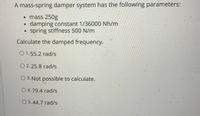
Elements Of Electromagnetics
7th Edition
ISBN: 9780190698614
Author: Sadiku, Matthew N. O.
Publisher: Oxford University Press
expand_more
expand_more
format_list_bulleted
Concept explainers
Question

Transcribed Image Text:A mass-spring damper system has the following parameters:
• mass 250g
damping constant 1/36000 Nh/m
• spring stiffness 500 N/m
Calculate the damped frequency.
O 1.55.2 rad/s
O 2.25.8 rad/s
O 3. Not possible to calculate.
O 4.79.4 rad/s
O 5.44.7 rad/s
Expert Solution
This question has been solved!
Explore an expertly crafted, step-by-step solution for a thorough understanding of key concepts.
Step by stepSolved in 2 steps with 2 images

Knowledge Booster
Learn more about
Need a deep-dive on the concept behind this application? Look no further. Learn more about this topic, mechanical-engineering and related others by exploring similar questions and additional content below.Similar questions
- A vehicle moving horizontally gets a load of wind resistance acting in the opposite direction to the vehicle's motion F M cv? v is the horizontal speed of the vehicle. F is the thrust that comes from the vehicle engine c damping coefficient for wind resistance force (c =0.20 N.sec2/m2) M is the mass of the vehicle (M = 1000 kg) Using Newton's 2nd law, we get the equation of motion dv 1000- + 0,2 v² = F dt At steady state the speed of the car is vo = 30 m/s and thrust F, = 0.2 v3 = 180 N. If the car is moving at a speed around steady state v = vo + dv = 180 and F = F, + 8F, derive a linear differential equation connecting d(dv) ,8v and SF. dtarrow_forwardA force of F = 50 N is applied to the rope that causes the angle 0₁ = 60 degrees to keep the system at equilibrium. The N spring constant is k = 100 m B a 0₁ с a b с Variable Value 2 m 2 m 2 m F b Values for the figure are given in the following table. Note the figure may not be to scale. cc i❀O BY NC SA 2013 Michael Swanbomarrow_forwardIs this Correct?arrow_forward
- QUESTION 3 Vibration absorber (also called tuned mass damper) is used to reduce* the vibration at the natural frequency of the original system. Consider a M-K system shown below. Original System x(t) Modified System x₁(1) X2(t) K K MA M 0000 M F(1) F(t) absorber K This system has a natural frequency at rad. The absorber mass and the spring are attached to the original system as shown in the figure, and the values are selected so that (1) the amplitude of the original mass, M. at the original natural frequency is zero, and (2) the new natural frequencies are moved away from the original natural frequency. The selection of absorber mass and stiffness, m and k, is easy. They have the same ratio as the ratio of the original system. That is, M/m = Klk. Find the transfer functions X1(s)/F(s) and X2(s)/F(s) before you can answer questions. What is the fundamental frequency (first natural frequency) of the modified system in rad/s? Use scientific notation with 3 signifincant figures. Omit…arrow_forwardA) Assuming that no inputs are present to a first-order and a second-order systems, mention two fundamental differences between the two systems. B) Determine the damping ratio and natural frequency of the single-loop RLC electrical circuit system shown below. d²1 dI I + R + = dt² dt с L E(t). C) State two distinctions between odd and even functions, and name and sketch a function that's neither odd nor even. D) What is the frequency in Hertz and the amplitude of the 5th term (i.e. the 4th harmonics) of the following signal? 4 2π 10π == - sin TT 4 бп y(t) (² t) + 37 sin (17) 4 + sin 5π (10+) +. 10 10arrow_forwardCan you help me solve this showing all the steps?arrow_forward
- Break down how got the answer simply? For period what is as?arrow_forwardDo not make any mistake.arrow_forwardFree Vibration Acceleration Time History 0.5 1,-0.424 sec Accel, 0.423 g 0.4 0.3 t4.958 sec Accel0.194 g 02 0.1 -0.1- -0.2 -0.3 -0.4- -0.5 Time (sec) Calculate the natural frequency of the structure from the experimental testing results shown below which were obtained from a free vibration test of the SDOF structure. Acceleration (arrow_forward
arrow_back_ios
arrow_forward_ios
Recommended textbooks for you
 Elements Of ElectromagneticsMechanical EngineeringISBN:9780190698614Author:Sadiku, Matthew N. O.Publisher:Oxford University Press
Elements Of ElectromagneticsMechanical EngineeringISBN:9780190698614Author:Sadiku, Matthew N. O.Publisher:Oxford University Press Mechanics of Materials (10th Edition)Mechanical EngineeringISBN:9780134319650Author:Russell C. HibbelerPublisher:PEARSON
Mechanics of Materials (10th Edition)Mechanical EngineeringISBN:9780134319650Author:Russell C. HibbelerPublisher:PEARSON Thermodynamics: An Engineering ApproachMechanical EngineeringISBN:9781259822674Author:Yunus A. Cengel Dr., Michael A. BolesPublisher:McGraw-Hill Education
Thermodynamics: An Engineering ApproachMechanical EngineeringISBN:9781259822674Author:Yunus A. Cengel Dr., Michael A. BolesPublisher:McGraw-Hill Education Control Systems EngineeringMechanical EngineeringISBN:9781118170519Author:Norman S. NisePublisher:WILEY
Control Systems EngineeringMechanical EngineeringISBN:9781118170519Author:Norman S. NisePublisher:WILEY Mechanics of Materials (MindTap Course List)Mechanical EngineeringISBN:9781337093347Author:Barry J. Goodno, James M. GerePublisher:Cengage Learning
Mechanics of Materials (MindTap Course List)Mechanical EngineeringISBN:9781337093347Author:Barry J. Goodno, James M. GerePublisher:Cengage Learning Engineering Mechanics: StaticsMechanical EngineeringISBN:9781118807330Author:James L. Meriam, L. G. Kraige, J. N. BoltonPublisher:WILEY
Engineering Mechanics: StaticsMechanical EngineeringISBN:9781118807330Author:James L. Meriam, L. G. Kraige, J. N. BoltonPublisher:WILEY

Elements Of Electromagnetics
Mechanical Engineering
ISBN:9780190698614
Author:Sadiku, Matthew N. O.
Publisher:Oxford University Press

Mechanics of Materials (10th Edition)
Mechanical Engineering
ISBN:9780134319650
Author:Russell C. Hibbeler
Publisher:PEARSON

Thermodynamics: An Engineering Approach
Mechanical Engineering
ISBN:9781259822674
Author:Yunus A. Cengel Dr., Michael A. Boles
Publisher:McGraw-Hill Education

Control Systems Engineering
Mechanical Engineering
ISBN:9781118170519
Author:Norman S. Nise
Publisher:WILEY

Mechanics of Materials (MindTap Course List)
Mechanical Engineering
ISBN:9781337093347
Author:Barry J. Goodno, James M. Gere
Publisher:Cengage Learning

Engineering Mechanics: Statics
Mechanical Engineering
ISBN:9781118807330
Author:James L. Meriam, L. G. Kraige, J. N. Bolton
Publisher:WILEY